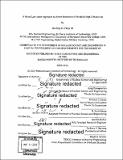| dc.description.abstract | This research demonstrates that multiple mono-energetic gamma lines produced from low threshold, high-Q nuclear reactions can be used to detect the presence of high-Z material shielded in low- and medium-Z cargo. Specifically, this work establishes a research foundation to inform the eventual development and optimization of a new type of low-dose, rapid-scan, transmission radiography imaging system designed to detect the presence of special nuclear material in cargo. This thesis explores the processes, reactions, and detection methods that may be used to develop a transmission imaging system significantly different from existing interrogation methods and major systems currently deployed in the field. This thesis introduces the nuclear smuggling issue, provides relevant background information, and defines the high-Z material detection problem. It also provides a brief overview of SNM detection efforts, to include both passive and active detection, and shows why active detection methods are needed to detect shielded SNM. The thesis then explains the underlying physics important to multiple monoenergetic gamma line imaging and defines key concepts to the characterization of cargo. An overview of the experimental concept and setup, to include development of a theoretical model to predict imaging counts, simulations conducted in support of the experiment, the presence and mitigation of neutrons in the beam line, major equipment and materials used, and the data acquisition and analysis software programs employed is then provided. This work considers and explains the difficulties of scanning of homogeneous and non-homogeneous cargoes, potential scanning system vulnerabilities to high-Z material smuggling, and suggests future efforts to address these vulnerabilities. The purpose, conduct, and results of 161 individual tests are provided. Finally, this thesis provides conclusions and recommendations for future work that could lead to development of a better cargo scanning system. Key achievements of this thesis included development of a simple attenuation model to predict the theoretical ratio of two monoenergetic gamma lines transmitted through complex cargo, exploration of the ability to discriminate between medium and high-Z materials both as pure cargo and when embedded in Fe, and the This research demonstrates that multiple mono-energetic gamma lines produced from low threshold, high-Q nuclear reactions can be used to detect the presence of high-Z material shielded in low- and medium-Z cargo. Specifically, this work establishes a research foundation to inform the eventual development and optimization of a new type of low-dose, rapid-scan, transmission radiography imaging system designed to detect the presence of special nuclear material in cargo. This thesis explores the processes, reactions, and detection methods that may be used to develop a transmission imaging system significantly different from existing interrogation methods and major systems currently deployed in the field. This thesis introduces the nuclear smuggling issue, provides relevant background information, and defines the high-Z material detection problem. It also provides a brief overview of SNM detection efforts, to include both passive and active detection, and shows why active detection methods are needed to detect shielded SNM. The thesis then explains the underlying physics important to multiple monoenergetic gamma line imaging and defines key concepts to the characterization of cargo. An overview of the experimental concept and setup, to include development of a theoretical model to predict imaging counts, simulations conducted in support of the experiment, the presence and mitigation of neutrons in the beam line, major equipment and materials used, and the data acquisition and analysis software programs employed is then provided. This work considers and explains the difficulties of scanning of homogeneous and non-homogeneous cargoes, potential scanning system vulnerabilities to high-Z material smuggling, and suggests future efforts to address these vulnerabilities. The purpose, conduct, and results of 161 individual tests are provided. Finally, this thesis provides conclusions and recommendations for future work that could lead to development of a better cargo scanning system. Key achievements of this thesis included development of a simple attenuation model to predict the theoretical ratio of two monoenergetic gamma lines transmitted through complex cargo, exploration of the ability to discriminate between medium and high-Z materials both as pure cargo and when embedded in Fe, and the | en_US |
